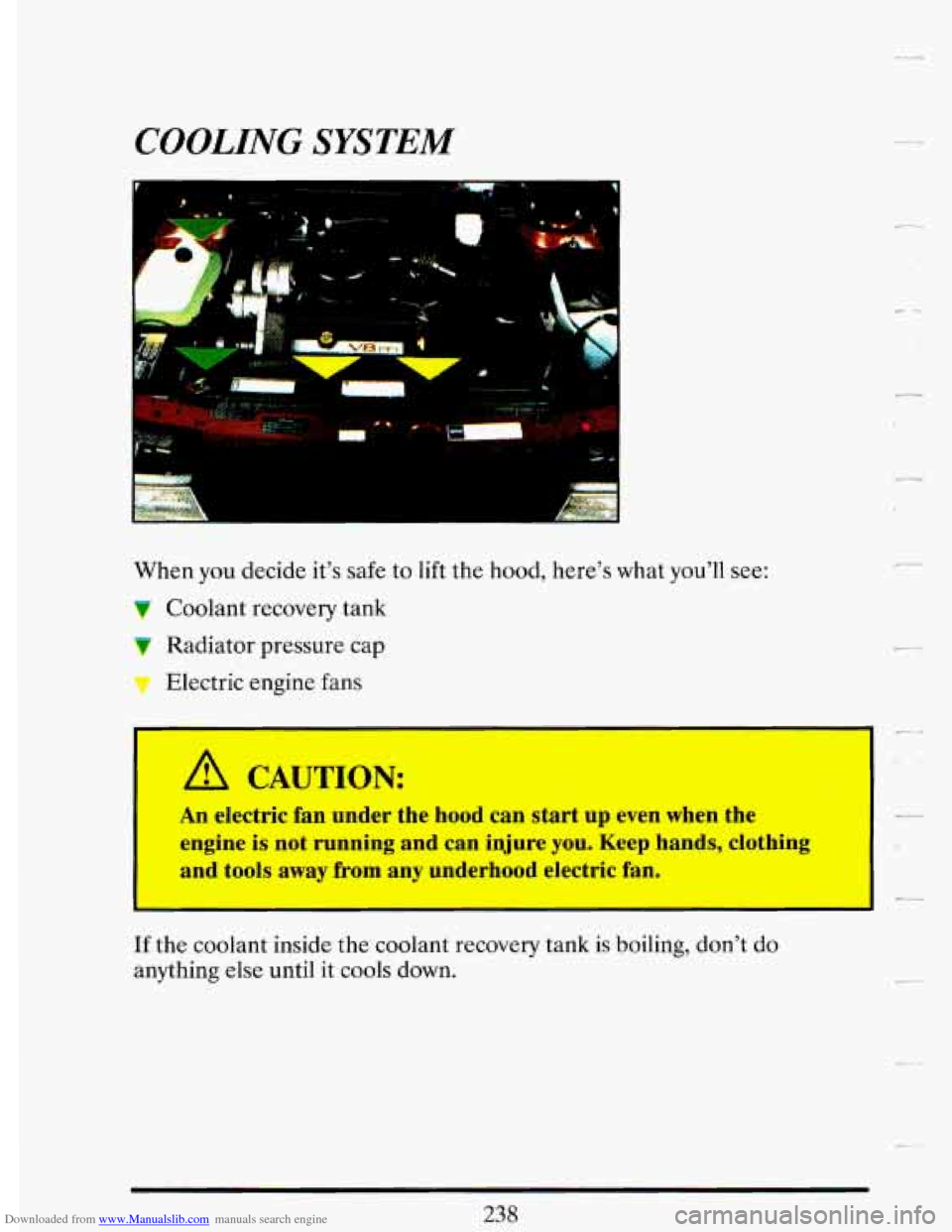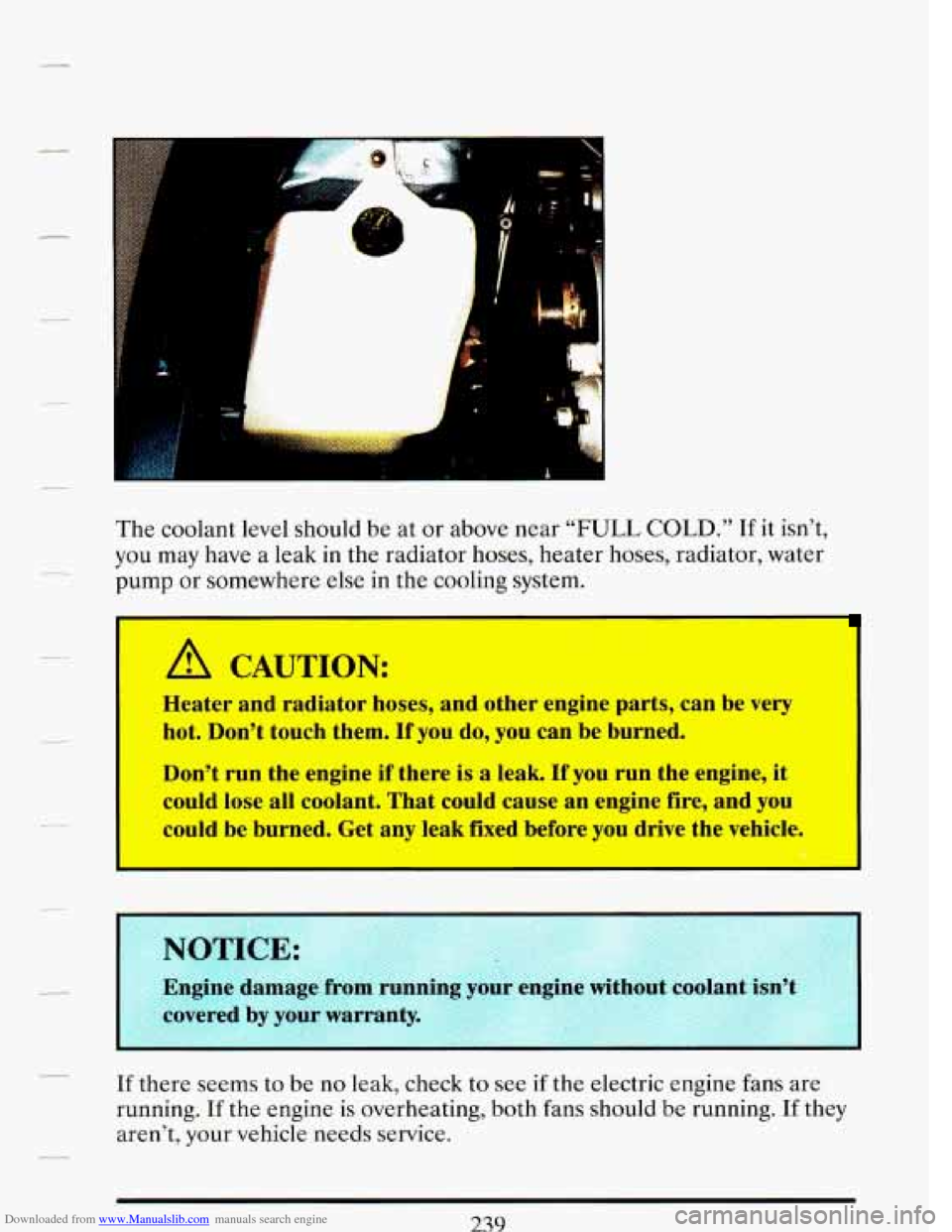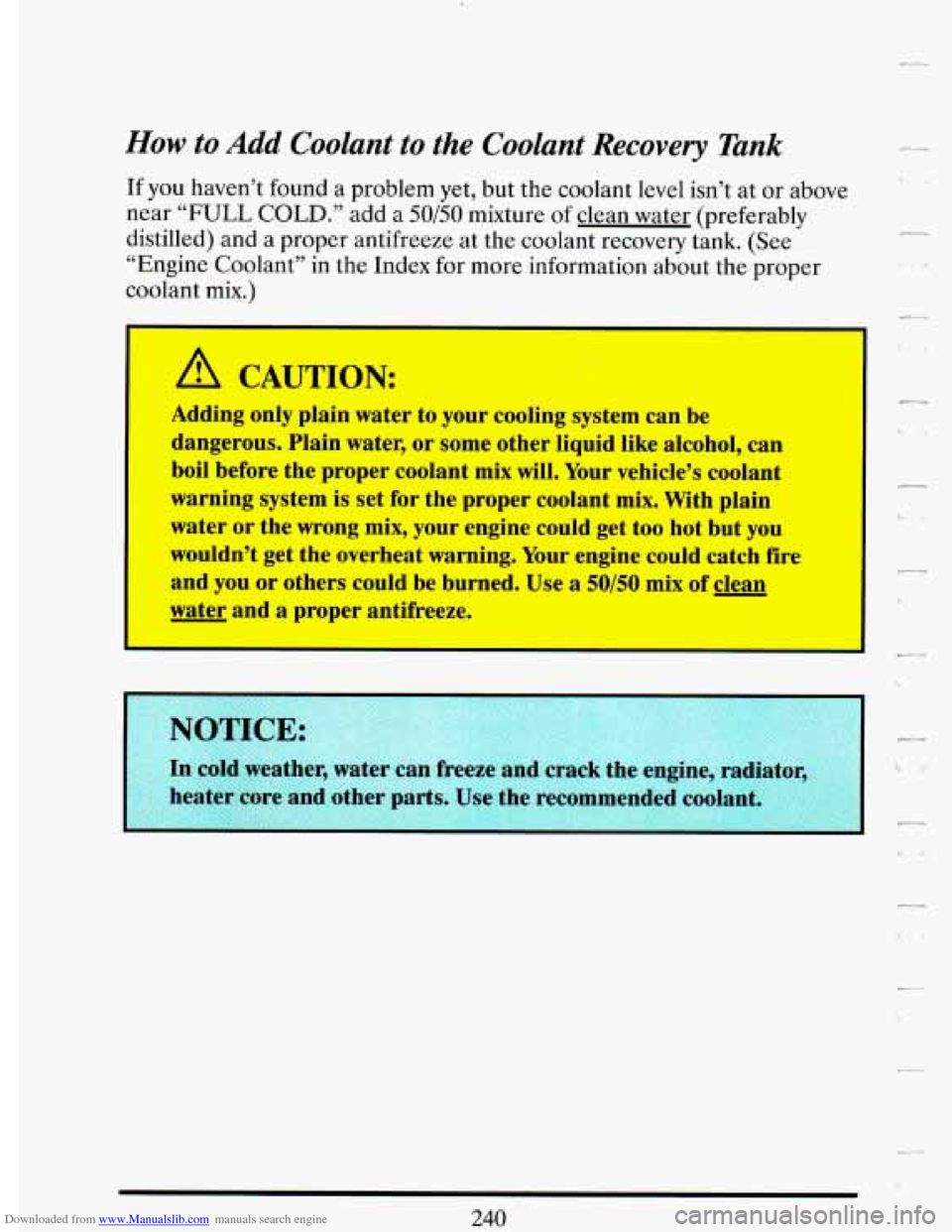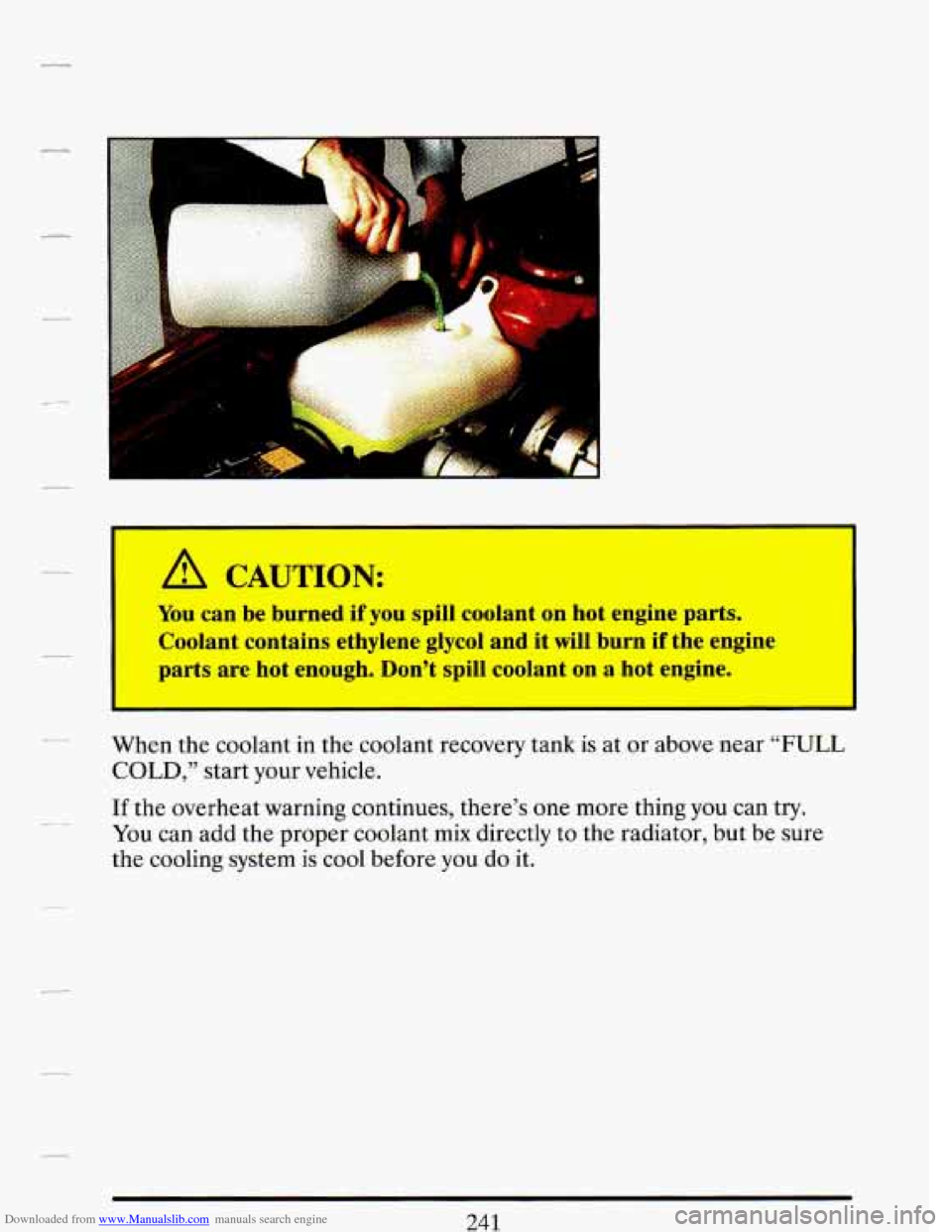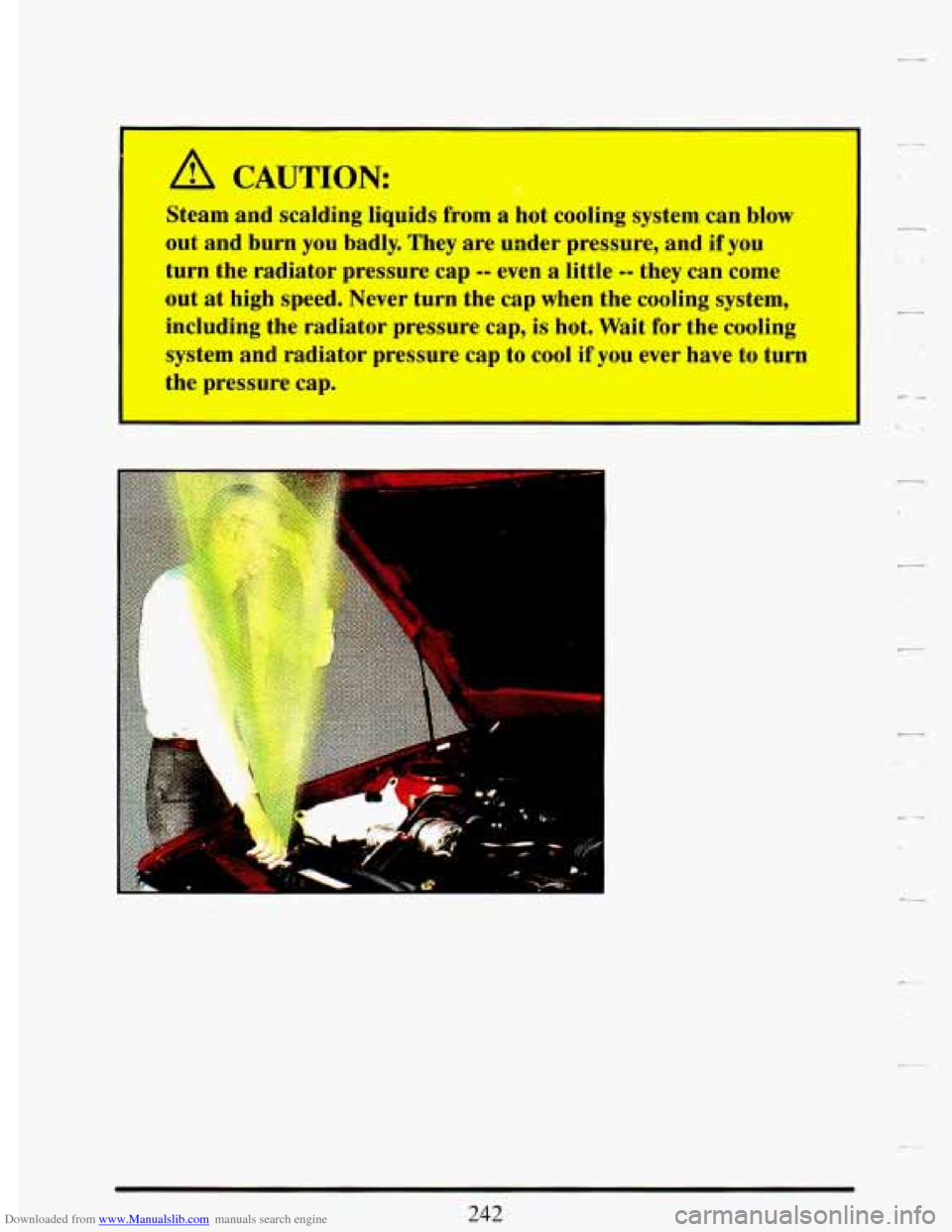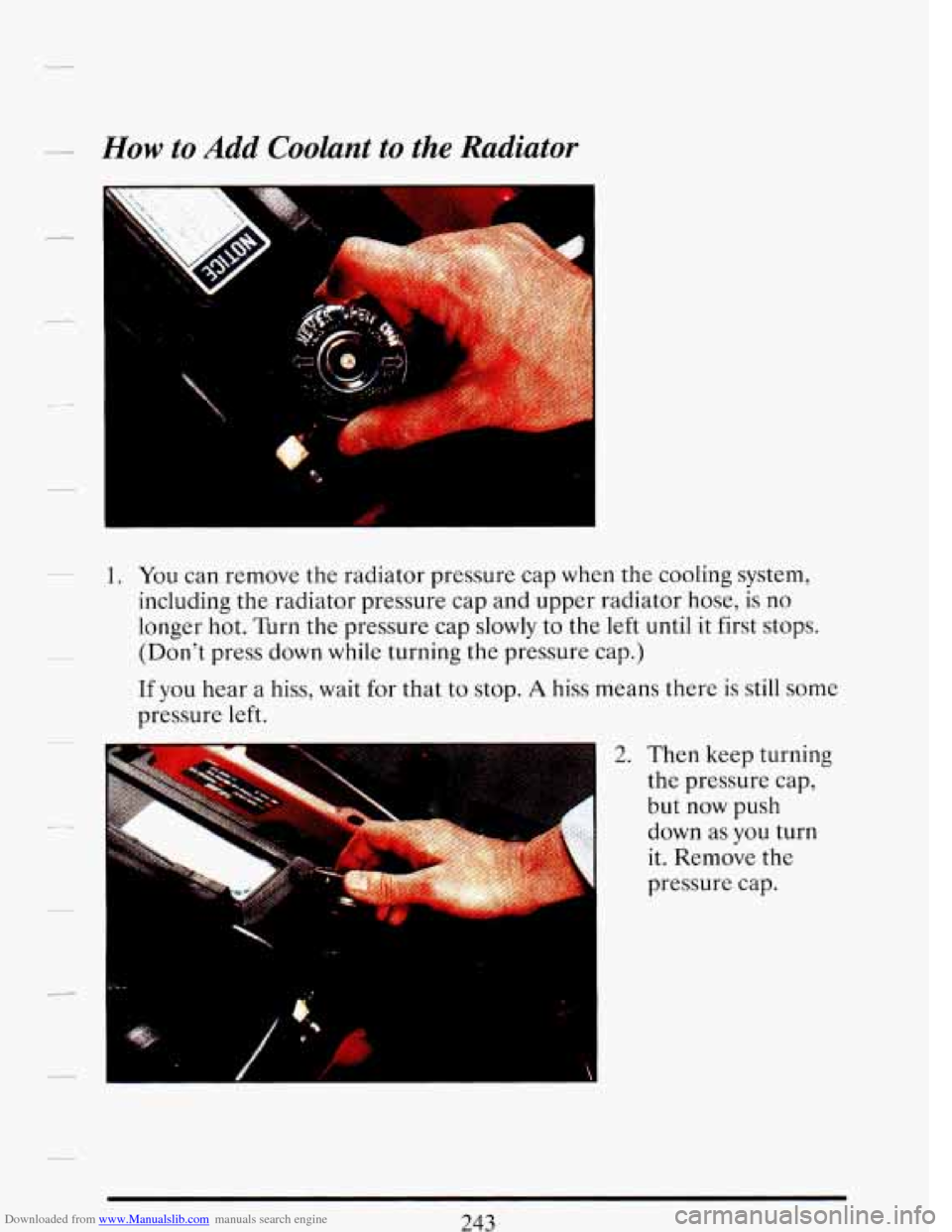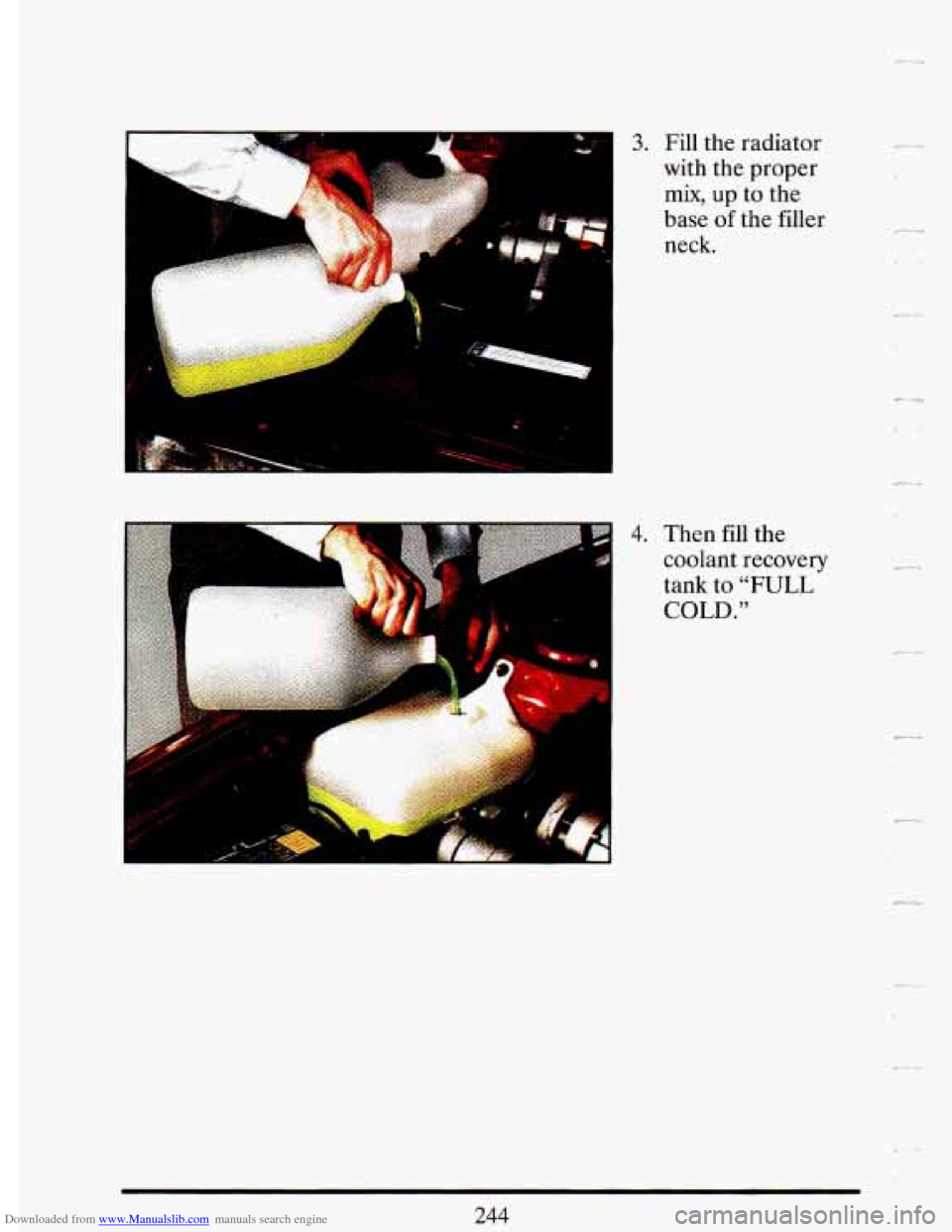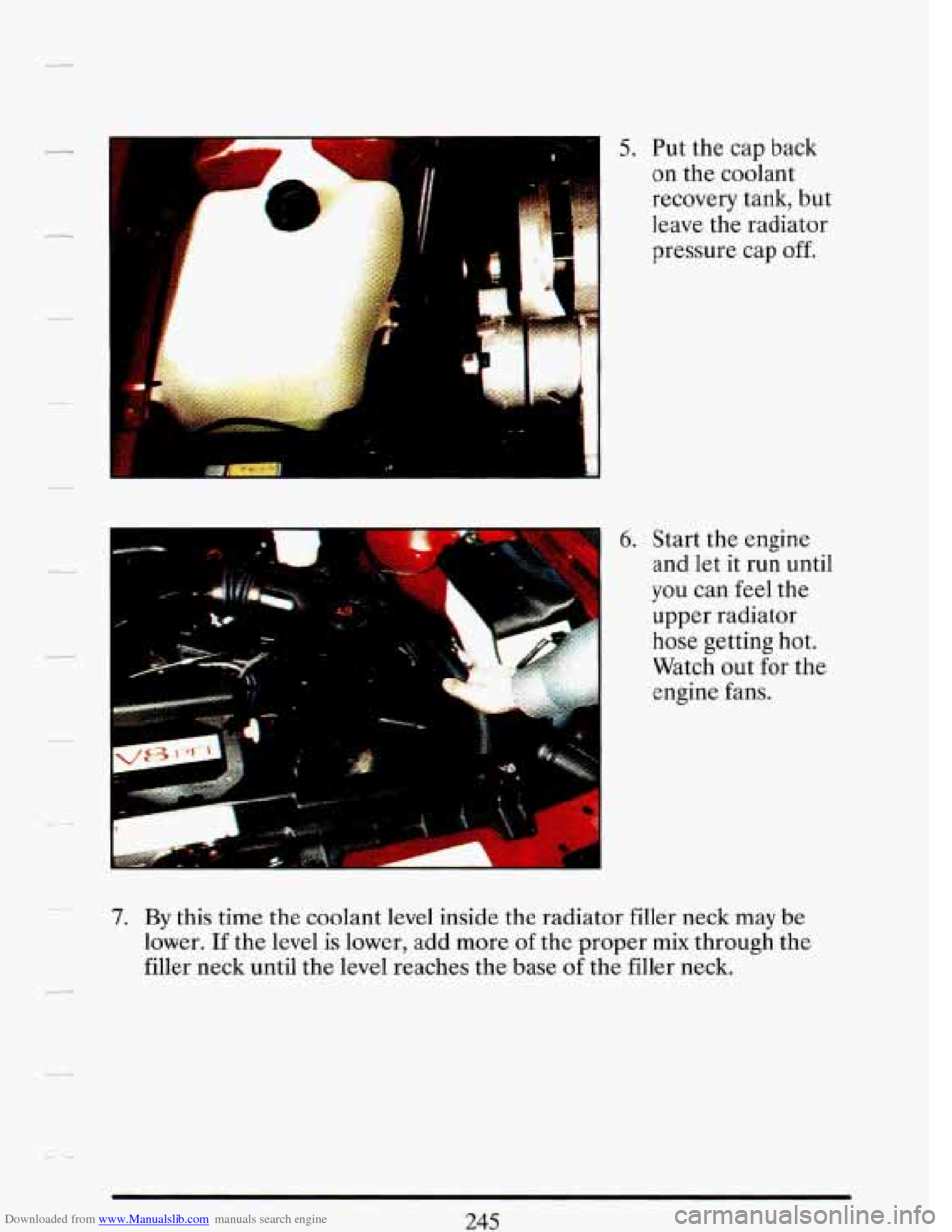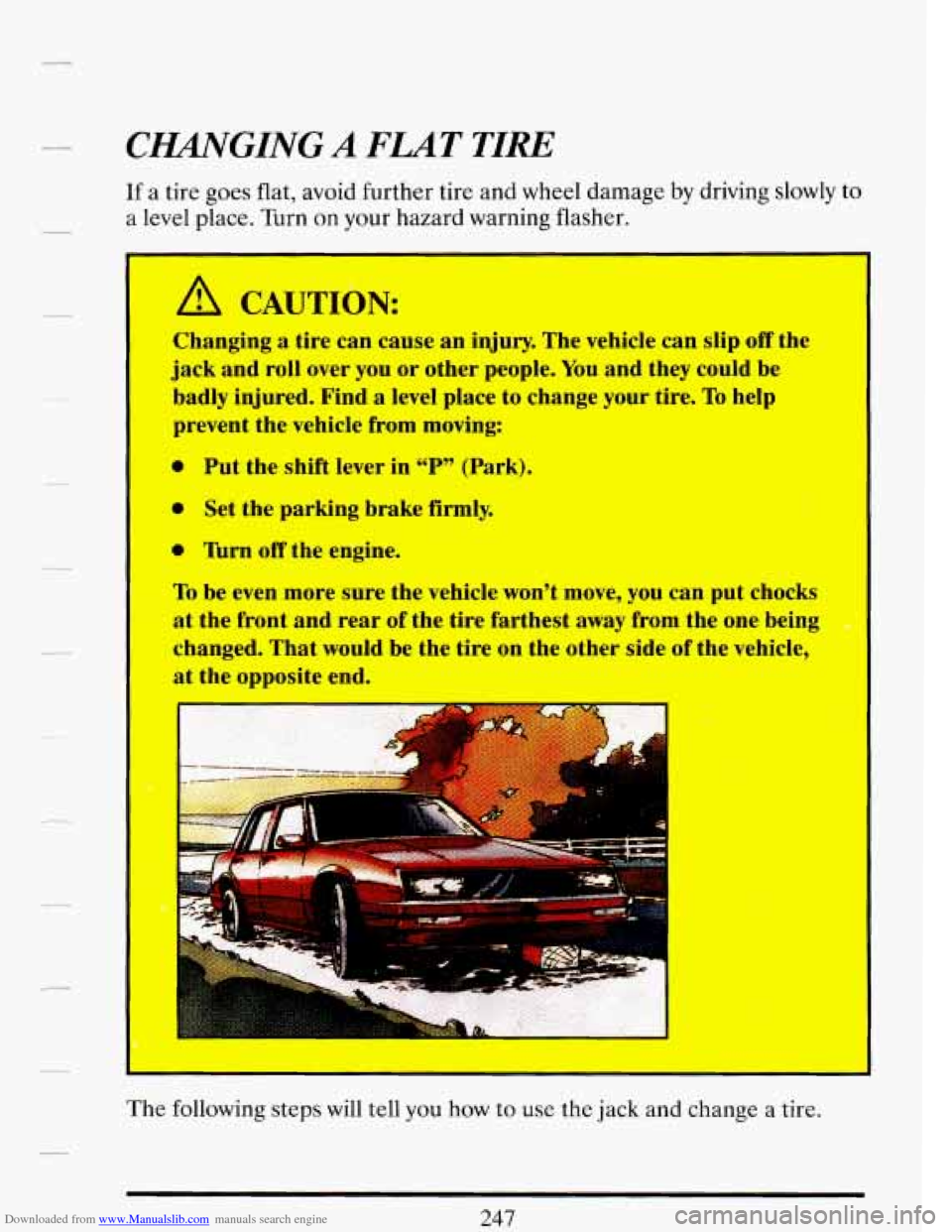CADILLAC DEVILLE 1993 7.G Owners Manual
DEVILLE 1993 7.G
CADILLAC
CADILLAC
https://www.carmanualsonline.info/img/23/7977/w960_7977-0.png
CADILLAC DEVILLE 1993 7.G Owners Manual
Trending: service, fuel pump, lock, climate control, towing capacity, glove box, coolant
Page 251 of 406
Downloaded from www.Manualslib.com manuals search engine COOLING SYSTEM
. .. .. .
-6’ - ..... .3 c. .- c
t ‘I
When you decide it’s safe to lift the hood, here’s what you’ll see:
Coolant recovery tank
7 Radiator pressure cap
7 Electric engine fans
’ A CAUTION: I
An electric fan under the hood can start up even when the
engine
is not running and can injure you. Keep hands, clothing
and tools away from any underhood electric fan.
If the coolant inside the coolant recovery tank is boiling, don’t do
anything else until it cools down.
238
Page 252 of 406
Downloaded from www.Manualslib.com manuals search engine The coolant level should be at or above near “FULL COLD.” If it isn’t,
you may have
a leak in the radiator hoses, heater hoses, radiator, water
pump or somewhere else in the cooling system.
A CAUTION:
Heater and radiator hoses, and other engine parts, can be very
hot. Don’t touch them. If you do, you can be burned.
Dodbrun the engine if there is a leak. If you run the engine, it
could lose all coolant. That could cause an engine fire, and you
could be burned. Get any leak Pied before you drive the vehicle.
ng your engine witrwut coularr~ isn’t
If there seems to be no leak, check to see if the electric engine fans are
running.
If the engine is overheating, both fans should be running. If they
aren’t, your vehicle needs service.
239
Page 253 of 406
Downloaded from www.Manualslib.com manuals search engine How to Add Coolant to the Coolant Recovery Tank
If you haven’t found a problem yet, but the coolant level isn’t at or above
near
“FULL COLD.” add a 50/50 mixture of clean water (preferably
distilled) and a proper antifreeze at the coolant recovery tank. (See
“Engine Coolant”
in the Index for more information about the proper
coolant mix.)
1
A CAUTION: i
Jding only plain water to your cooling system can be
dangerous. Plain water, or some other liquid like alcohol, can
boil before the proper coolant mix will. Your vehicle’s coolant
warning system is set for the proper coolant mix. With plain
water
or the wrong mix, your engine could get too hot but you
wouldn’t get the overheat warning. Your engine could catch fire
and you or others could be burned. Use
a 50/50 mix of clean
water and
a proper antifreeze.
I
t--
iL ,&
r-
c-
240
Page 254 of 406
Downloaded from www.Manualslib.com manuals search engine c-
A CAUTION:
You can be burned if you spill coolant on hot engine parts.
Coolant contains ethylene glycol and it will burn if the engine
parts are hot enough. Don’t spill coolant on a hot engine.
I
When the coolant in the coolant recovery tank is at or above near “FULL
COLD,” start your vehicle.
If the overheat warning continues, there’s one more thing you can try.
You can add the proper coolant mix directly to the radiator, but be sure
the cooling system is cool before you do it.
241
Page 255 of 406
Downloaded from www.Manualslib.com manuals search engine 0
Steam and scalding liquids from a hot cooling system can blow
out and
burn you badly. They are under pressure, and if you
turn the radiator pressure'cap
-- even a little -- they can come
out at high speed. Never turn the cap when the cooling system,
including the radiator pressure cap,
is hot. Wait for the cooling
system
and radiator pressure cap to cool if you ever have to turn
the pressure cap.
U.
7-
Lr
Page 256 of 406
Downloaded from www.Manualslib.com manuals search engine How to Add Coolant to the Radiator
1. You can remove the radiator pressure cap when the cooling system,
including the radiator pressure cap and upper radiator hose, is
no
longer hot. Turn the pressure cap slowly to the left until it first stops.
(Don’t press down
while turning the pressure cap.)
If you hear a hiss, wait
for that to stop. A hiss means there is still some
pressure left.
1
i
2. Then keep turning
the pressure cap,
but
now push
down
as you turn
it. Remove the
pressure cap.
243
Page 257 of 406
Downloaded from www.Manualslib.com manuals search engine i .& . 1-
3. Fill the radiator
with the proper
mix, up to the
base of
the filler
neck.
c-
kr
4. Then fill the
coolant recovery
tank
to “FULL
COLD. ”
Page 258 of 406
Downloaded from www.Manualslib.com manuals search engine 7
5. Put the cap back
on the coolant
recovery tank, but
leave the radiator
pressure cap
off.
6. Start the engine
and let it run
until
you can feel the
upper radiator
hose getting hot.
Watch out for the
engine fans.
7. By this time the coolant level inside the radiator filler neck may be
lower. If the level is lower, add more of the proper mix through the
filler neck until the
level reaches the base of the filler neck.
245
Page 259 of 406
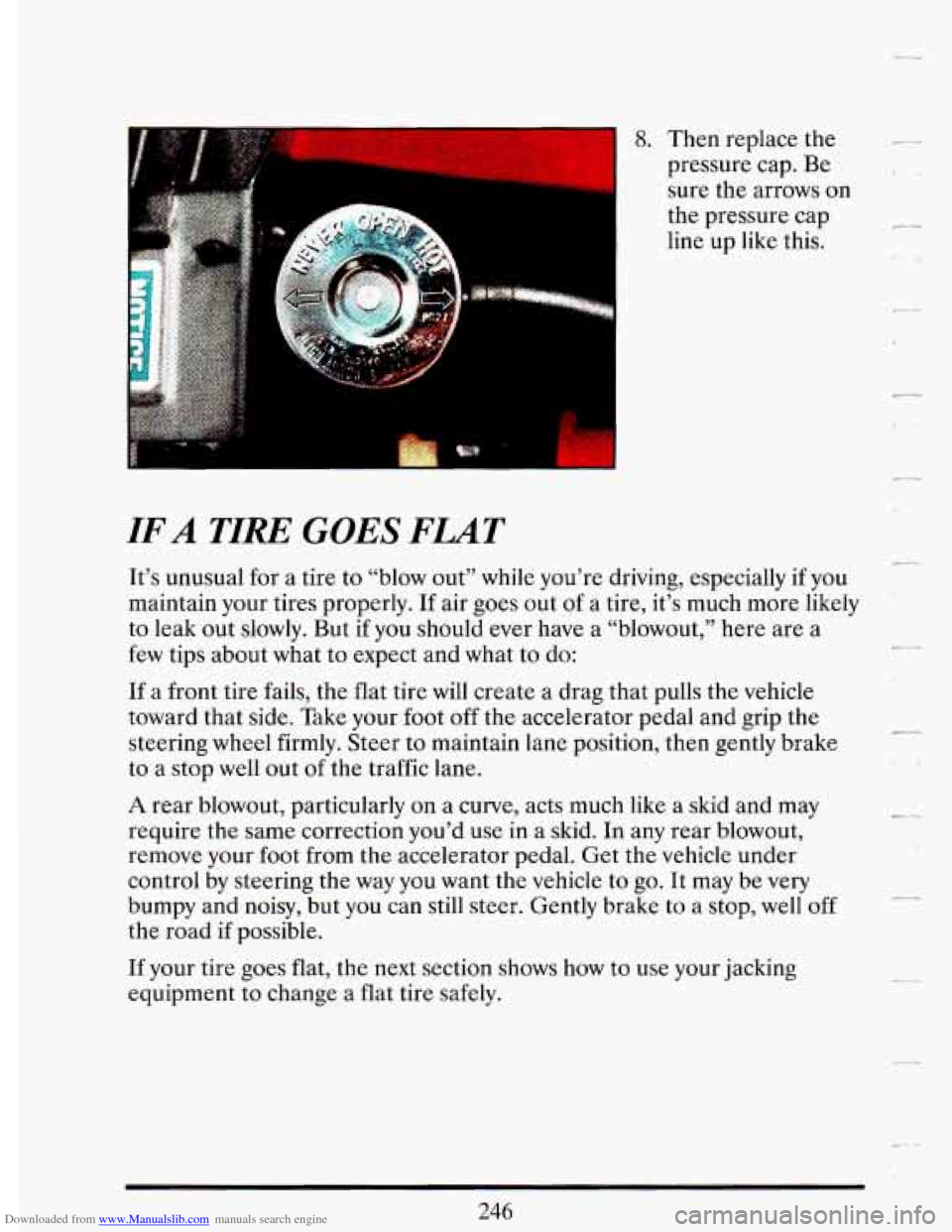
Downloaded from www.Manualslib.com manuals search engine I 8. Then replace the
pressure cap. Be sure the arrows on
the pressure cap
line up like this.
IF A TIRE GOES FLAT
It’s unusual for a tire to “blow out” while you’re driving, especially if you
maintain your tires properly. If air goes out
of a tire, it’s much more likely
to leak out slowly. But if you should ever have a “blowout,” here are a
few tips about what to expect and what to do:
If a front tire fails, the flat tire will create a drag that pulls the vehicle
toward that side. Take your foot
off the accelerator pedal and grip the
steering wheel firmly. Steer to maintain lane position, then gently brake
to a stop well out
of the traffic lane.
A rear blowout, particularly on a curve, acts much like a skid and may
require the same correction you’d use
in a skid. In any rear blowout,
remove your foot from the accelerator pedal. Get the vehicle under
control by steering the way you want the vehicle to go.
It may be very
bumpy and noisy, but you can still steer. Gently brake
to a stop, well off
the road if possible.
If your tire goes flat, the next section shows how to use your jacking
equipment to change a flat tire safely.
Page 260 of 406
Downloaded from www.Manualslib.com manuals search engine CWGING A FLAT TIRE
If a tire goes flat, avoid further tire and wheel damage by driving slowly to
a level place. Turn on your hazard warning flasher.
A CAUTION:
Changing a tire can cause an injury. The vehicle can slip off the
jack and roll over you or other people. You and they could be
badly injured. Find a level place to change your tire. To help
prevent the vehicle from moving:
0 Put the shift lever in “P” (Park).
0 Set the parking brake firmly.
0 Turn off the engine.
To be even more sure the vehicle won’t move, you can put chocks
at the front and rear of the tire farthest away from the one being
changed. That would be the tire on the other side of the vehicle,
at the opposite end.
I
The following steps will tell you how to use the jack and change a tire.
Trending: keyless entry, engine overheat, jump start, warning lights, coolant level, fog light, stop start
